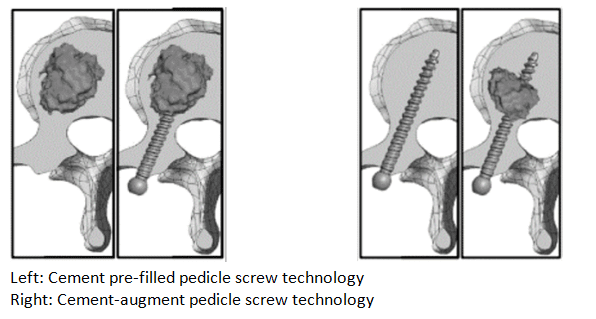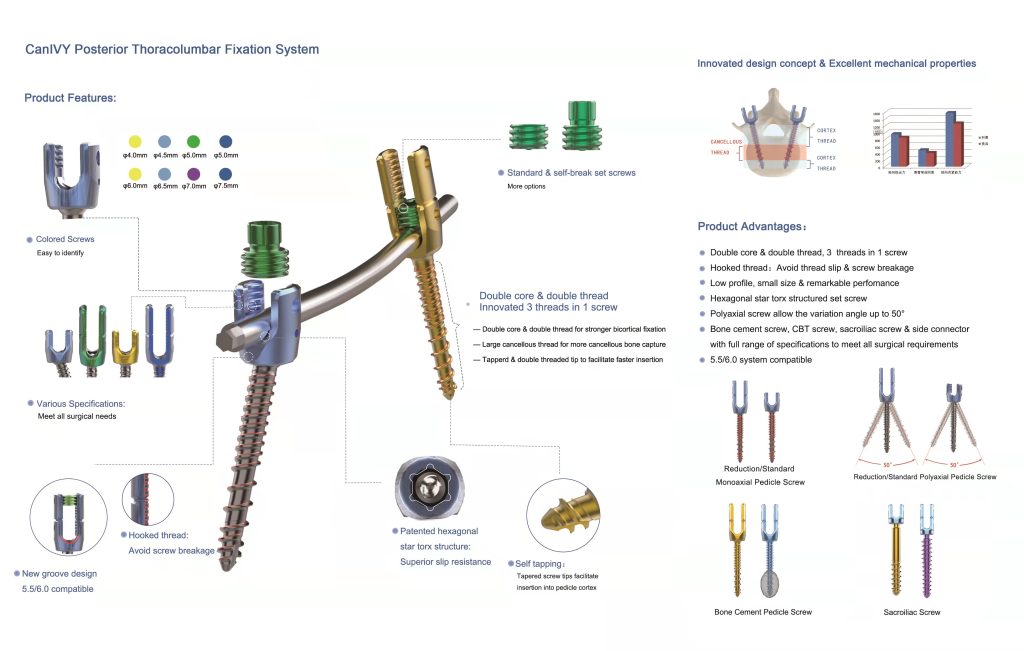With the advent of an aging society, spinal degenerative diseases often coexist with osteoporosis; in patients with osteoporosis, problems such as loosening, pulling out, and fracture of pedicle screws are severe for spine surgeons challenge; Therefore fenestrated pedicle screw technology came into being!
The history and main forms of fenestrated pedicle screw
In 1994, bone cement-enhanced pedicle screw technology was first applied in the internal fixation of patients with degenerative scoliosis, mainly by implanting pedicle screws after injecting bone cement into the formed pedicle screw channel to fulfill,
That is the cement pre-filled pedicle screw technology.
In 2000, a cannulated pedicle screw with a side hole designed with bone cement reinforcement technology appeared. After this type of screw is implanted, bone cement can be directly injected into the vertebral body through the cannulated part of the screw. This is our current practice. And is the most widely used fenestrated pedicle screw technology, is the cement-augment pedicle screw technology.

Indications for fenestrated pedicle screw technique:
- Severe osteoporosis combined with spinal degenerative diseases requires decompression and internal fixation surgery
- Spinal fixation revision surgery
- Isometric segmental spinal fixation surgery for kyphoscoliosis correction.
In the long-segment spinal fixation surgery for the elderly, the screws at the head and tail end have a higher probability of loosening, and several pairs of screws at the head and tail ends are often selectively strengthened, especially when the head end involves the thoracolumbar junction. Play a role in preventing nail pulling and preventing PJK (proximal junctional kyphosis)
Risks for fenestrated pedicle screw technique:
- Bone cement leakage, causing spinal cord compression and neurological symptoms;
- If the position of the screw is not good, revision surgery is relatively difficult;
- Foreign body reaction of bone cement, etc.
Applications skills for fenestrated pedicle screw technique:
- Measure the length and size of the screw channel of the corresponding pedicle through CT scan before operation, so as to have a preliminary understanding of the length and size of the pedicle screw that needs to be placed during the operation;
- Accurately judge the position of the screw, open the circuit accurately, and tap the thread to avoid the rupture of the pedicle; try to place the screw in one step during the screw insertion process, and avoid repeatedly adjusting the position of the screw channel;
- Before intraoperative bone cement injection, use methylprednisolone and other hormones to prevent foreign body reactions;
- Bone cement should be injected during the toothpaste period, and it is impossible to inject bone cement too early in order to prolong the operation time, which may lead to complications such as leakage of bone cement into blood vessels;
- Repeated C-arm fluoroscopy several times to understand the leakage of bone cement, especially the leakage at the posterior edge of the vertebral body;
- The injection of bone cement should be done after the decompression of the lamina, so that after leakage occurs, the leakage of bone cement can be removed before the bone cement solidifies; for segments that do not need decompression, the amount of bone cement can be appropriately reduced or repeated multiple times. Second perspective confirmation.
- 2.0-3.0 mL of bone cement can maximize the fixation strength, too much bone cement will not increase the pull-out strength, but will increase the risk of bone cement leakage.
Risks for fenestrated pedicle screw technique:
- Bone cement leakage, causing spinal cord compression and neurological symptoms;
- If the position of the screw is not good, revision surgery is relatively difficult;
- Foreign body reaction of bone cement, etc.
Applications skills for fenestrated pedicle screw technique:
- Measure the length and size of the screw channel of the corresponding pedicle through CT scan before operation, so as to have a preliminary understanding of the length and size of the pedicle screw that needs to be placed during the operation;
- Accurately judge the position of the screw, open the circuit accurately, and tap the thread to avoid the rupture of the pedicle; try to place the screw in one step during the screw insertion process, and avoid repeatedly adjusting the position of the screw channel;
- Before intraoperative bone cement injection, use methylprednisolone and other hormones to prevent foreign body reactions;
- Bone cement should be injected during the toothpaste period, and it is impossible to inject bone cement too early in order to prolong the operation time, which may lead to complications such as leakage of bone cement into blood vessels;
- Repeated C-arm fluoroscopy several times to understand the leakage of bone cement, especially the leakage at the posterior edge of the vertebral body;
- The injection of bone cement should be done after the decompression of the lamina, so that after leakage occurs, the leakage of bone cement can be removed before the bone cement solidifies; for segments that do not need decompression, the amount of bone cement can be appropriately reduced or repeated multiple times. Second perspective confirmation.
- 2.0-3.0 mL of bone cement can maximize the fixation strength, too much bone cement will not increase the pull-out strength, but will increase the risk of bone cement leakage.
Cement pre-filled pedicle screw technology technic
The main key is how to use the bone cement pusher to control the position of the bone cement:
Concentrated method: use the bone cement pusher to inject the bone cement into one position in the vertebral body, usually the central 1/3 of the vertebral body, and provide reinforcement at this specific single position;
Withdrawal method: Use the bone cement pusher to inject bone cement from the top of the screw canal while slowly retracting the pusher to diffuse the bone cement in the vertebral part of the screw canal, thereby providing reinforcement.

Mark the depth of the screw path on the bone cement pusher to accurately control the depth and location of the pusher and bone cement diffusion;
The bone cement pusher with side opening can be used to artificially make the bone cement reach the desired position along the screw path;
If a large number of pedicle screws are placed, the bone cement injection and screw placement time for each screw is relatively short. It is recommended not to force the bone cement to fill the entire vertebral part of the screw tract, so as not to increase the risk of bone cement leakage.
Cement-augment pedicle screw technology technic
After the pedicle screw track is obtained during the operation, it is advisable to measure the length of the pedicle screw track again to select a pedicle screw with an appropriate length; personal experience is to try to choose a relatively long screw and increase the screw penetration depth.
Key 1: The position of the most proximal side hole
The proximal hole is the first channel through which the bone cement diffuses to the periphery after entering the screw. The amount of bone cement diffused through this hole is relatively large, and the proximal hole is closest to the posterior edge of the vertebral body, where bone cement leakage occurs at the highest risk.
Key 2: Selection of screws with different numbers of side holes
The bone cement dispersion of the less-side hole type screws (2-4 holes) is relatively concentrated in the local part of the screw, which can better prevent bone cement leakage, but the amount of bone cement injected and the subsequent holding force are relatively weak;
The bone cement of multi-hole screws (6-8 holes) can be better diffused around the whole screw along the screw channel, and the holding force is stronger but the risk of leakage increases;

If conditions permit, pedicle screws can be placed under navigation guidance or nerve monitoring can be used during the operation to confirm that the pedicle screws are placed correctly.
Problems to be paid attention to after bone cement injection:
Reversely rotate the screw 180-360° to break the connection between the bone cement and the screw, reduce the torque and pull-out force required for the second removal, and prepare for possible revision;
Prompt exploration and cleaning after bone cement leakage is very important. Pay attention to avoid secondary spinal cord injury caused by surgical operation during the exploration and cleaning process;
When fenestrated pedicle screws are implanted, after the position of the screw is determined, the screw tail should be checked, and the bone cement on the protruding surface should be removed as soon as possible to avoid difficulty in screwing.
In the realm of medical advancements, precision, and innovation are paramount, and the CanIVY pedicle screws stand at the forefront of groundbreaking spinal technology. These screws are compatible with both 5.5mm and 6.0mm rods. With their low-profile, small size, and remarkable performance, CanIVY pedicle Screws are revolutionizing spinal fixation.
One of the key innovations in these screws is their unique double core and double thread design, offering three threads in a single screw. This ingenious engineering not only enhances stability but also ensures stronger bicortical fixation. The large cancellous thread captures more cancellous bone, while the tapered, double-threaded tip facilitates faster and smoother insertion. And their distinctive color-coded design, providing easy identification during surgical procedures.
But innovation doesn’t stop there. CanIVY comes with upgraded instruments for one-step operation, streamlining surgical procedures for efficiency and safety. The patented hexagonal star torx structure enhances slip resistance, further ensuring the reliability of the fixation.
For spinal surgeons seeking optimal cement dispersion, CanIVY offers cannulated and multiple side holes. These features contribute to stable cement dispersion, a crucial aspect of spinal surgery.


Conclusion
Fenestrated pedicle screw technology is widely used in patients with degenerative spinal diseases and osteoporosis. At present, the two main technologies have their own advantages and disadvantages, and different details and skills need to be paid attention to during the application process. Familiar with two different fenestrated pedicle screw technologies, according to the specific situation in the operation, balance safety and stability, choose flexibly, and maximize the strength of pedicle screws on the basis of minimizing complications.